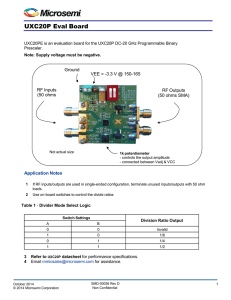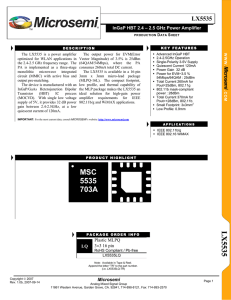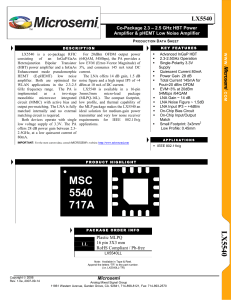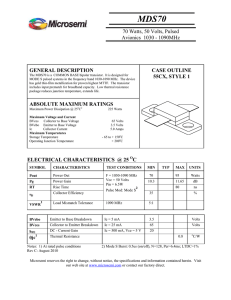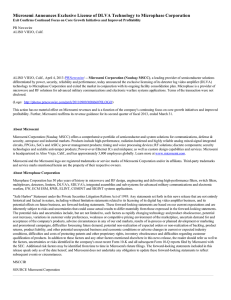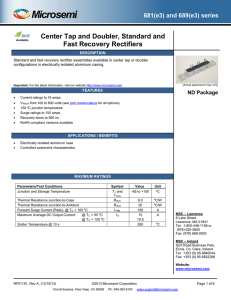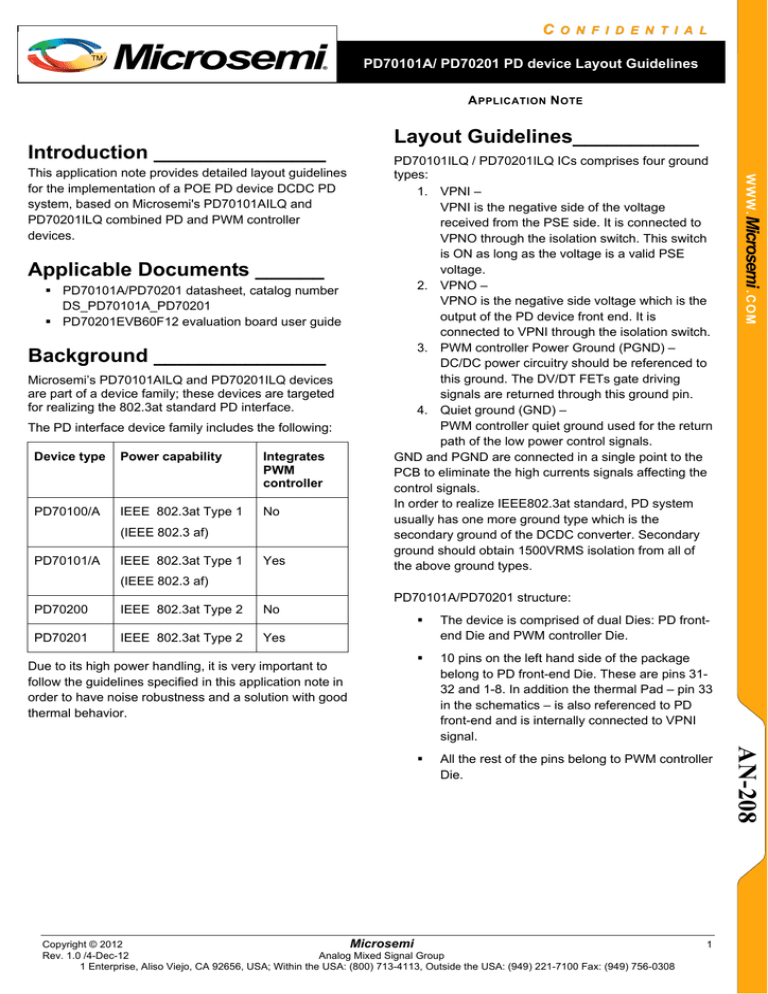
C
TM
O N F I D E N T I A L
PD70101A/ PD70201 PD device Layout Guidelines
A PPLICATION N OTE
Introduction _______________
Applicable Documents ______
PD70101A/PD70201 datasheet, catalog number
DS_PD70101A_PD70201
PD70201EVB60F12 evaluation board user guide
Background _______________
Microsemi’s PD70101AILQ and PD70201ILQ devices
are part of a device family; these devices are targeted
for realizing the 802.3at standard PD interface.
The PD interface device family includes the following:
Device type
Power capability
Integrates
PWM
controller
PD70100/A
IEEE 802.3at Type 1
No
(IEEE 802.3 af)
PD70101/A
IEEE 802.3at Type 1
Yes
PD70101ILQ / PD70201ILQ ICs comprises four ground
types:
1. VPNI –
VPNI is the negative side of the voltage
received from the PSE side. It is connected to
VPNO through the isolation switch. This switch
is ON as long as the voltage is a valid PSE
voltage.
2. VPNO –
VPNO is the negative side voltage which is the
output of the PD device front end. It is
connected to VPNI through the isolation switch.
3. PWM controller Power Ground (PGND) –
DC/DC power circuitry should be referenced to
this ground. The DV/DT FETs gate driving
signals are returned through this ground pin.
4. Quiet ground (GND) –
PWM controller quiet ground used for the return
path of the low power control signals.
GND and PGND are connected in a single point to the
PCB to eliminate the high currents signals affecting the
control signals.
In order to realize IEEE802.3at standard, PD system
usually has one more ground type which is the
secondary ground of the DCDC converter. Secondary
ground should obtain 1500VRMS isolation from all of
the above ground types.
WWW . Microsemi .C OM
This application note provides detailed layout guidelines
for the implementation of a POE PD device DCDC PD
system, based on Microsemi's PD70101AILQ and
PD70201ILQ combined PD and PWM controller
devices.
Layout Guidelines___________
(IEEE 802.3 af)
PD70200
IEEE 802.3at Type 2
No
PD70201
IEEE 802.3at Type 2
Yes
Due to its high power handling, it is very important to
follow the guidelines specified in this application note in
order to have noise robustness and a solution with good
thermal behavior.
PD70101A/PD70201 structure:
The device is comprised of dual Dies: PD frontend Die and PWM controller Die.
10 pins on the left hand side of the package
belong to PD front-end Die. These are pins 3132 and 1-8. In addition the thermal Pad – pin 33
in the schematics – is also referenced to PD
front-end and is internally connected to VPNI
signal.
All the rest of the pins belong to PWM controller
Die.
Copyright © 2012
Microsemi
Rev. 1.0 /4-Dec-12
Analog Mixed Signal Group
1 Enterprise, Aliso Viejo, CA 92656, USA; Within the USA: (800) 713-4113, Outside the USA: (949) 221-7100 Fax: (949) 756-0308
1
AN-208
C
TM
O N F I D E N T I A L
PD70101A/ PD70201 PD device Layout Guidelines
A PPLICATION N OTE
WWW . Microsemi .C OM
Figure 1: System Based on PD70201ILQ
AN-208
Figure 2: PD70201EVB60F12 EVB power loops and power flow
Copyright © 2012
Microsemi
Rev. 1.0 /4-Dec-12
Analog Mixed Signal Group
1 Enterprise, Aliso Viejo, CA 92656, USA; Within the USA: (800) 713-4113, Outside the USA: (949) 221-7100 Fax: (949) 756-0308
2
C
TM
O N F I D E N T I A L
PD70101A/ PD70201 PD device Layout Guidelines
A PPLICATION N OTE
Input Stage
Input stage includes the following elements:
Input RJ45 connectors
Line transformer
Diode bridge
Common mode choke
PD70101A/PD70201 device
Bulk capacitor for DCDC input filter.
In this set of elements, the current is floating in
continuous form (non-switched).
The first 4 elements should be placed next to each
other in order to enable the common mode choke to
filter the noise close to RJ45 connector.
To have low radiation design, the layout of the positive
input and of the negative input should be in a differential
form. This means that the positive rail is always as tight
as possible to the negative one. See blue and RED
lines in Figure 3.
DCDC Converter Stage.
Figure 3 depict two current pathways of driver's power
section. When Primary FET is on, current flows through
input On loop. When Primary FET is off, current flows
through output Off loop.
Locating components close to each other within a loop,
allows a shorter current loop. As a result, high currents
remain in the driver's power block (and out of ground
return path of quiet components). For the On Loop
place CIN, power transformer, sense resistors, and
Primary FET as close as possible to each other.
For the Off Loop, place power XFMR, Sync FET and
COUT as close as possible to each other.
WWW . Microsemi .C OM
PD is comprised of some generic parts.
Input stage.
DCDC converter stage
Output stage.
Figure 3 shows the current flow through these stages
for the PD70201EVB60F12 evaluation board.
Among the above elements the diode bridges and PD
device are the only elements that dissipate high power
and get heated. Therefore copper land for heat sinking
should be maintained for them.
Figure 3: Current Path During ON/Off Times
PD70101A/ PD70201
PD70101A/PD70201 power dissipation is mainly a
function of the device’s switching FET resistance
and system Current.
P=SW_RDSon x Max current
Note: although the PD device is the controller of the
DCDC converter its location should be determined by
its Conducting features. A proper layout will allow
control from a distance.
AN-208
Place both the PD70101A/PD70201 device and its
peripheral on the top side so that the bottom layer
will be used as a Power dissipation layer. Keep it in
as solid as possible VPNI potential.
For the layout, use the pattern land shown in Figure
10. Vias under the device are used for heat transfer
between layers.
If there are inner layers, use them for extended
copper land under the device to improve heat
dissipation.
Place VPNi/Vpp capacitors as close as possible to
PD70101A/PD70201, between pins 5 and 32.
Place PD70101A/PD70201 bypass capacitors as
close as possible to the device.
Traces
Figure 4 depicts the high current traces. It is marked in
RED and highlighted by a yellow background.
Make all high current traces as short and direct as
possible. The trace thickness should withstand its
current values with low temperature rise.
Note: Power is flowing out of VPNo signal, and not
PGND.
Figure 4: High current traces Layout
Copyright © 2012
Microsemi
Rev. 1.0 /4-Dec-12
Analog Mixed Signal Group
1 Enterprise, Aliso Viejo, CA 92656, USA; Within the USA: (800) 713-4113, Outside the USA: (949) 221-7100 Fax: (949) 756-0308
3
C
TM
O N F I D E N T I A L
PD70101A/ PD70201 PD device Layout Guidelines
A PPLICATION N OTE
Primary and Secondary FETs
Sensing of the primary loop current is done using 1%
+/-100ppm low resistance resistors connected as a
shunt.
Primary and secondary FETs are high power devices. A
FET should have copper land to enable power
dissipation from it to the environment.
Copper land is a function of the FET package power
consumption and the system requirements.
Figure 6 depicts DCDC converter MOSFET layout.
Calculate DCDC converter FET power dissipation to
Choose MOSFET’s package and thermal pad size
according to calculation results. If you use two
MOSFETs, connect them in parallel.
Figure 5 depicts the right way to layout the power
supply sense resistors.
Calculate sense resistor power dissipation. Choose
resistor size and number of resistors according to
calculation result.
The sense resistors’ voltage is in the range of 0 to
200mV and exists in an environment of fast transitions
of up to 160V. The form of the current sense signal is
very important and its integrity must be maintained.
Thus the sense voltage traces layout should be
maintained carefully.
In order to simplify the integrity challenge,
PD70101A/PD70201 has a differential sampling
mechanism built of pins CSP & CSN.
Route differential traces from sense resistor terminals to
CSN and CSP input pins. They should be connected as
a Kelvin connection, as close as possible to the
resistors pads, and should not be part of the high
current path to the resistors. This way, voltage
measurement is not influenced by voltage drop on the
high power traces.
The two lines should be routed together close to each
other in order to maintain good noise immunity. For the
resistor high current trace, use a Wide trace or copper
planes to decrease trace voltage drop.
WWW . Microsemi .C OM
Sense Resistors:
Figure 6: MOSFET Layout
MOSFET Design Example:
System Specifications:
Tja _ abs _ max 150C (absolute maximum taken
from data sheet)
Tja _ max 120C (design margin from data sheet
absolute maximum value)
TMAX = 70ºC (maximum ambient temperature)
∆T = Tja _ max - TMAX = 50ºC (maximum required
temperature rise on MOSFET case)
PMOSFET = 1.3W (Maximum FET power based on
static and dynamic losses calculation)
Due to MOSFET high power dissipation, chosen
MOSFET package is D2PAK with pad size of 1x1inch
(25.4x25.4 mm).
Θja=35 ºC/W (see figure 9)
Tja 35 1.3 45.5C
AN-208
Temperature rise is within system specification.
Figure 5: Sense Resistor Layout
Copyright © 2012
Microsemi
Rev. 1.0 /4-Dec-12
Analog Mixed Signal Group
1 Enterprise, Aliso Viejo, CA 92656, USA; Within the USA: (800) 713-4113, Outside the USA: (949) 221-7100 Fax: (949) 756-0308
4
C
TM
O N F I D E N T I A L
PD70101A/ PD70201 PD device Layout Guidelines
A PPLICATION N OTE
Driving
WWW . Microsemi .C OM
Figure 7: Thermal Resistance versus Drain Pad
Area for D2PAK Package
Gate drive pulses are supplied to the primary and
secondary gates and are generated by the PWM
controller section of the PD70x01 devices.
In order to increase efficiency and still decrease the
temperature rise of the FETs, a fast slew rate pulses
should be obtained.
PD70x01 device drivers have internal serial output
resistance. To overcome this internal resistance and
also the distance of the controller from the FETs, extra
driving components are used. For proper operation of
the driving elements, pull up transistor, pull down
transistor, and bypass capacitor should be as close as
possible to the referenced FET.
Isolation
Snubbers
For an isolated DCDC design such as Flyback, Isolation
level is based on IEEE 802.3AT standard.
IEEE 802.3AT standard defines 1500Vrms isolation to be
obtained between all accessible external conductors
including frame ground (if any), RJ45 connector leads,
and all internal leads of the PD such as secondary side
traces.
So isolation should be maintained between Flyback
converter primary and secondary sides and between
Frame ground and secondary side.
1500Vrms isolation is obtained by having a gap of 60mil
between the traces of the primary domain and the
secondary domain.
The isolation line of separation should include power
transformer, secondary gate pulse transformer, optocouplers, and Primary/secondary 2000V capacitor.
The Capacitor should be located close to the power
transformer to help fighting conducted emission issues
if raised.
Do not mix the two isolated sides. Mixing the sides may
cause signals to mix and thus difficulty in maintaining
the isolation.
Use a physical Isolation line as presented in Figure 8.
Figure 9 depicts Snubbers location.
Snubbers are elements that are aimed to protect FETs
from high voltage spikes that are produced due to
system parasitic. For example, in the primary domain,
the transformer inductance reaction to current switching
creates high voltage spikes.
To overcome this issue, Snubber is placed in parallel to
the transformer primary winding, and should be placed
as close as possible to it. The proximity of those is very
important in order to reduce the voltage spikes on the
Drain-Source of the primary FET.
The location, in the bottom side under the transformer,
yields a low inductance connection. The Snubber can
be comprised of serial resistor and capacitor (RC
Snubber), resistor capacitor and diode (RCD), or active
Snubber that also uses inductor.
The Secondary side Snubber is usually an RC Snubber,
and should be located very close to the secondary FET,
between Drain and source.
AN-208
Figure 9: Snubbers Location
Figure 8: Isolation Line
There should not be a plane layout under the primary
and secondary sides of the power transformer.
Copyright © 2012
Microsemi
Rev. 1.0 /4-Dec-12
Analog Mixed Signal Group
1 Enterprise, Aliso Viejo, CA 92656, USA; Within the USA: (800) 713-4113, Outside the USA: (949) 221-7100 Fax: (949) 756-0308
5
C
TM
O N F I D E N T I A L
PD70101A/ PD70201 PD device Layout Guidelines
A PPLICATION N OTE
Heat Sinking
WWW . Microsemi .C OM
The components that usually dissipate the major power
portion and as a result heat up are:
Primary FET
Secondary FET
Power Transformer
PD70x01 device
Primary Snubber components
Secondary snubber components.
Board design should provide an adequate copper land
for dissipating the heat of those components.
For PD70101A/PD70201 use the pattern land shown in
Figure 10 for the layout. Vias under the device are used
for heat transfer between layers. Use 25 mil Vias for
effective heat transfer between layers .As a first priority
use external layers for the heat dissipation; If can be
done using the internal layers as well for good heat
transfer.
Design example
On Figure 14 to Figure 18 you can see the layout of
PD70201EVB60F12 evaluation board for reference.
This board can be ordered from Microsemi.
AN-208
Copyright © 2012
Microsemi
Rev. 1.0 /4-Dec-12
Analog Mixed Signal Group
1 Enterprise, Aliso Viejo, CA 92656, USA; Within the USA: (800) 713-4113, Outside the USA: (949) 221-7100 Fax: (949) 756-0308
6
C
TM
O N F I D E N T I A L
PD70101A/ PD70201 PD device Layout Guidelines
A PPLICATION N OTE
WWW . Microsemi .C OM
Figure 10: PD70201ILQ Recommended PCB Layout for Thermal Pad Array (mm)
Figure 11: PD70201ILQ Bottom layer Recommended PCB Layout for Thermal Pad
Array (mm)
AN-208
Copyright © 2012
Microsemi
Rev. 1.0 /4-Dec-12
Analog Mixed Signal Group
1 Enterprise, Aliso Viejo, CA 92656, USA; Within the USA: (800) 713-4113, Outside the USA: (949) 221-7100 Fax: (949) 756-0308
7
C
TM
O N F I D E N T I A L
PD70101A/ PD70201 PD device Layout Guidelines
A PPLICATION N OTE
5.23
0.4
0.6
WWW . Microsemi .C OM
Ap
er
tu
r
e
Figure 12: LX23214ILQ Recommended PCB Layout for Thermal Pad Array Footprint
(PS)
AN-208
Copyright © 2012
Microsemi
Rev. 1.0 /4-Dec-12
Analog Mixed Signal Group
1 Enterprise, Aliso Viejo, CA 92656, USA; Within the USA: (800) 713-4113, Outside the USA: (949) 221-7100 Fax: (949) 756-0308
8
C
TM
O N F I D E N T I A L
PD70101A/ PD70201 PD device Layout Guidelines
A PPLICATION N OTE
WWW . Microsemi .C OM
Figure 13: PD70201EVB60F12 EVB PCB Silk Top
Figure 14: PD70201EVB60F12 EVB PCB Top
AN-208
Copyright © 2012
Microsemi
Rev. 1.0 /4-Dec-12
Analog Mixed Signal Group
1 Enterprise, Aliso Viejo, CA 92656, USA; Within the USA: (800) 713-4113, Outside the USA: (949) 221-7100 Fax: (949) 756-0308
9
C
TM
O N F I D E N T I A L
PD70101A/ PD70201 PD device Layout Guidelines
A PPLICATION N OTE
WWW . Microsemi .C OM
Figure 15: PD70201EVB60F12 EVB PCB Layer 2
Figure 16: PD70201EVB60F12 EVB PCB Layer 3
AN-208
Copyright © 2012
Microsemi
Rev. 1.0 /4-Dec-12
Analog Mixed Signal Group
1 Enterprise, Aliso Viejo, CA 92656, USA; Within the USA: (800) 713-4113, Outside the USA: (949) 221-7100 Fax: (949) 756-0308
10
C
TM
O N F I D E N T I A L
PD70101A/ PD70201 PD device Layout Guidelines
A PPLICATION N OTE
WWW . Microsemi .C OM
Figure 17: PD70201EVB60F12 EVB PCB Bottom (Layer 4)
Figure 18: PD70201EVB60F12 EVB PCB Silk Bottom (Mirror)
AN-208
Copyright © 2012
Microsemi
Rev. 1.0 /4-Dec-12
Analog Mixed Signal Group
1 Enterprise, Aliso Viejo, CA 92656, USA; Within the USA: (800) 713-4113, Outside the USA: (949) 221-7100 Fax: (949) 756-0308
11
C
TM
O N F I D E N T I A L
PD70101A/ PD70201 PD device Layout Guidelines
A PPLICATION N OTE
Revision History
Revision Level / Date
1.0 / 04 December. 12
Para. Affected
-
Description
Initial Release – preliminary version
AN-208
© 2012Microsemi Corp.
All rights reserved.
For support contact: sales_AMSG@microsemi.com
Visit our web site at: www.microsemi.com
WWW . Microsemi .C OM
The information contained in the document is PROPRIETARY AND CONFIDENTIAL information of Microsemi and
cannot be copied, published, uploaded, posted, transmitted, distributed or disclosed or used without the express duly
signed written consent of Microsemi If the recipient of this document has entered into a disclosure agreement with
Microsemi, then the terms of such Agreement will also apply. This document and the information contained herein may
not be modified, by any person other than authorized personnel of Microsemi. No license under any patent, copyright,
trade secret or other intellectual property right is granted to or conferred upon you by disclosure or delivery of the
information, either expressly, by implication, inducement, estoppels or otherwise. Any license under such intellectual
property rights must be approved by Microsemi in writing signed by an officer of Microsemi.
Microsemi reserves the right to change the configuration, functionality and performance of its products at anytime
without any notice. This product has been subject to limited testing and should not be used in conjunction with lifesupport or other mission-critical equipment or applications. Microsemi assumes no liability whatsoever, and Microsemi
disclaims any express or implied warranty, relating to sale and/or use of Microsemi products including liability or
warranties relating to fitness for a particular purpose, merchantability, or infringement of any patent, copyright or other
intellectual property right. The product is subject to other terms and conditions which can be located on the web at
http://www.microsemi.com/legal/tnc.asp
Catalog Number: PD70101A_PD70201_AN208
Copyright © 2012
Microsemi
Rev. 1.0 /4-Dec-12
Analog Mixed Signal Group
1 Enterprise, Aliso Viejo, CA 92656, USA; Within the USA: (800) 713-4113, Outside the USA: (949) 221-7100 Fax: (949) 756-0308
12

